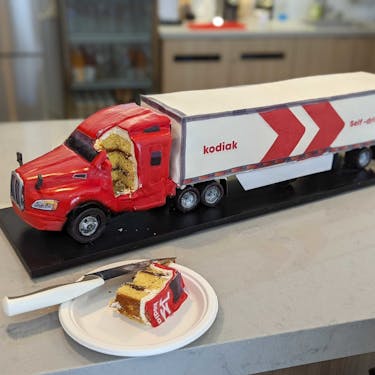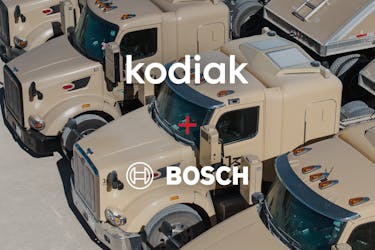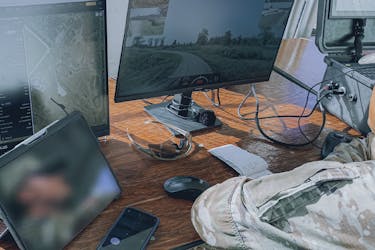Leading Kodiak AI into the future as CTO
|
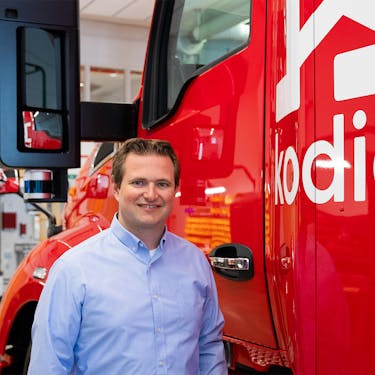
Kodiak AI’s Vision for a Safe and Scalable Autonomous Trucking Solution
I have been fascinated by autonomous vehicles from the moment I learned of them in the nascent days of the industry. The opportunity to work on a technology so interesting and so challenging while also being able to work on a product that can improve road safety and have a positive impact on the daily life of every person is not something that comes along very often. It is this passion that led me into this industry, and it is with a commitment to those ideals that I am excited to announce my new position as Chief Technology Officer (CTO) at Kodiak AI.
With this mission in mind, I want to delve further into my backstory in order to more deeply explain Kodiak AI’s vision for a safe and scalable autonomous trucking solution.
Developing the right product in a new industry
2022 marks my ninth year in autonomous driving, and my thirteenth year working on autonomous systems. That’s about as long as the industry has existed. I began my career in my native Austria, where I earned a PhD in Computer Science with a focus on computer vision and robotics. When I moved to the US to work on Google’s Self-Driving Vehicles, I got lots of questions about what a self-driving vehicle is, and if I really thought that this could ever work. Over the next few years we launched two autonomous passenger vehicles on public roads at what had become Waymo — first the cute Firefly vehicles in Texas, and then the larger minivans in Arizona. I was right there, both in all preparations and on-call in the operations room, eagerly watching the cars complete the first driverless rides ever. It was an amazing achievement, with many new safety methodologies having been developed and refined in the process. I got into the back of these cars, with nobody in front, on public roads; and I felt safe, because I knew about the detailed verification and validation work that went into making it happen. I learned that launching autonomous systems is all about bounding the problem, making all edge cases result in safe behavior even if that behavior is not efficient or comfortable quite yet.
This experience also made me think about the right product use case for autonomy. In my mind, autonomous technology has to be safe, or it is not worth doing. But once you get it to be safe, what is the best application to go after near-term? What do people actually need? I believe that robotaxis will someday provide safe and efficient transportation to many people. However, I am absolutely convinced that autonomous long-haul trucks will be even more critical and wide-spread. Autonomous trucks solve many problems that are stifling the trucking industry today, from improving safety on the often long and tiring trips across the country, to helping trucking companies retain drivers by keeping them local with their families, to adding reliable service capacity on long-haul routes where the fleets of today are not able to meet the incredible demand for shipping services anymore.
In 2018, I thus decided to focus on autonomous trucking, and to join Kodiak AI. As one of the founding engineers, I’ve helped build Kodiak AI from the beginning both in terms of the amazing team we have assembled and the solution we have built. I soon took on responsibility for our engineering path and became the Vice President of Engineering. I built the engineering team from the ground up, defined milestones, tackled challenges, and celebrated many accomplishments that our team has been able to show.
How Kodiak AI has established itself as a leader in autonomous trucking
Perhaps the thing I’m most proud of at Kodiak has been our rapid progress. We were able to get our first trucks up and running on public roads in less than a year, and hit disengage-free deliveries only a year and a half after that. In a very short time, we have developed technology, processes, and partnerships that make us one of the leaders in autonomous trucking.
Our Kodiak Driver, the software and hardware that operates our trucks, of course needs to support all capabilities needed to drive a truck safely, to a performance level that is comparable to a human driver. Over the eighteen months since we made our first disengage-free delivery, we’ve made countless improvements in our ability to navigate heavy traffic, safely adjust our lane and/or speed for vehicles on the shoulder hundreds of meters ahead, operate in inclement weather, nudge over for vehicles within the lane, and traverse tight road geometries such as cloverleaf interchanges, or Texas U-turns. These features in particular, require very tight motion planning and excellent perception; both are areas that Kodiak AI has made tremendous strides in 2021.
We have shown that our technology can easily scale to new environments, allowing us to rapidly expand our freight network. This sounds much easier than it is in practice. Kodiak AI is the first and only AV company that has been able to map new highways in a single pass, and then drive them just days later on first try without any safety disengages.
Our mapping speed is incredibly high; in summer of 2021 we had engaged our AV system in 2 states, with commercial deliveries just in Texas. As of spring 2022 we have now driven our AV system across the country and a total of 11 states, with commercial deliveries across 6 states. Our maps are being created and maintained by a team of only two employees, plus a lot of automation and real-time updates, as opposed to the hundreds of employees maintaining HD maps at some of our competitors. We call our proprietary technique sparse mapping, and it allows the trucking fleets we support to keep their trucks on the road. We have learned that next to safety, this is what matters most to them.
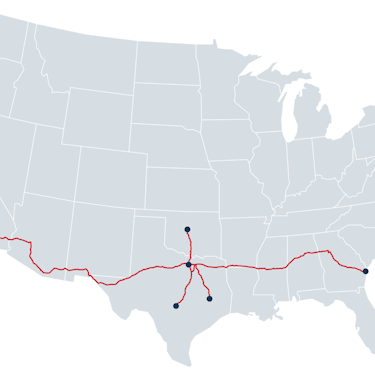
Our major fleet partners such as CEVA Logistics, U.S. Xpress, and others yet to be announced, ultimately need a product that is first and foremost safe, and next reliable and maintainable. An AV truck that is constantly down is of limited utility to a fleet. Our fourth-generation Kodiak Driver hardware was designed to provide this required level of hardware robustness, while our unique and patented mirror-mounted sensor pods allow for high serviceability. Our compute platform allows actuation of the vehicle with high integrity, developed towards the highest automotive safety standards. Our AV system has a universal interface to the truck, so that it can be easily ported to trucks of various brands. Where possible we can thus support pre-existing preferences and OEM relationships of our fleet partners. In recent deliveries for U.S. Xpress, our AV system completed 8 on-time back-to-back deliveries across 6,350 miles, and in the process ran for 131 hours nonstop; an industry-first.
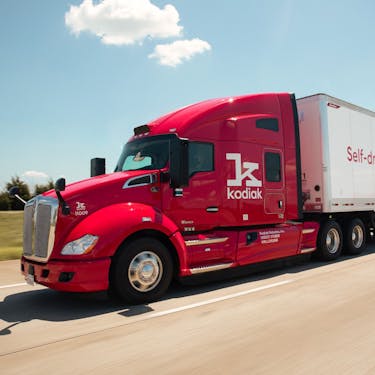
How did we achieve all of this in an incredibly short time? By being laser-focused on building safe technology for autonomous trucks, by hiring the best team in the industry which brings a lot of experience on how to and how not to pick possible technical solutions, and by working with the AV ecosystem instead of against it.
Where Kodiak AI is going
In addition to our rapid progress, I am proud of how we have built Kodiak AI with a tightly-focused solution in mind. We have focused on building the best truck driver, not just any driver; after all, not every human driver can drive a Class 8 semi either. We have focused on tackling an operational design domain (ODD) that is useful for long-haul trucking, not just for a demo; that means driving on the freeway even with construction zones and in 95% of all weather conditions, but not driving in urban city environments or crossing railroad tracks. We have also focused on launching safely, not just quickly; that means building a defensible safety case before taking the driver out on public roads.
Over the next few years, Kodiak AI will gradually unlock more and more situations where we can remove the driver from the vehicle. The process to do so started with our first ever autonomous drive in 2018 and the operational safety review leading up to it. Since then, we have evolved our analytical tools and have proven to ourselves that our trucks can be safely driven without a human driver at the wheel in a closed course environment. Getting there involved a large set of systems engineering tools and artifacts, such as hazard and risk analysis (HARA), fault tree analysis (FTA), and design failure mode and effect analysis (DFMEA). As I mentioned in the beginning, autonomous driving is all about bounding the problem: Our trucks thus have to handle any faults gracefully and assume a minimal risk condition where necessary. We’re proud to have had this functionality that we call “fallback maneuvers” from the beginning of Kodiak AI, as opposed to adding it as an afterthought. To fully take the driver out, even at a test track, many such faults need to be handled correctly and verifiably. While faults are rare in a well-engineered driverless vehicle, a huge truck should never operate without such a safety net.
To assess our driving performance in more complex scenarios, we use a mix of systematic analysis as described above, on-road driving, test-track miles, and a lion’s share of simulation. We have developed a large set of both real-world and synthetic cases that allow us to rapidly test the Kodiak Driver. Every disengagement by a safety driver gets automatically simulated and evaluated for its severity; while most of these driver takeovers are out of an abundance of caution, every now and then we still find a case where we are not yet on-par with a human. These edge cases help us bound and define our development roadmap as we build out Kodiak AI’s safety case.
Building a thorough safety case takes time, but luckily there are other parts of the product that can be built in parallel, with safety drivers behind the wheel. In 2022, we will continue to demonstrate technology achievements, while further growing Kodiak’s operations and industry partnerships through our new Partner Deployment Program. Those include fleets that we partner with to ship commercial goods around the country, but also partnerships to expand our AV development fleet.
2022 is a year of growth for Kodiak AI. Growth in network size, growth in fleet size, and growth in team size. We have recently hired our 140th employee, and almost doubled since mid 2021. My new role as CTO reflects this growth and change: I will continue to shape Kodiak’s technology, products, and services, but focus more on long-term strategy, rather than day-to-day operations. My new role will also include maintaining our culture of safety and respect for each other, facilitating deep discussions about the technology and the product while always keeping safety top of mind. We have a culture where diversity is valued. I am proud to be a leader in a company where personal life matters, and where employees like myself can take parental leave and vacation time despite the challenging and interesting work in front of us.
Whenever I look back, I am deeply impressed with what our incredibly capable team has achieved. I am even more excited about the future of Kodiak AI. Stay tuned for our news and sign up for our newsletter. And, of course, if you are passionate about autonomy or the future of transportation, come work with us and help build the best AV truck driver out there: The Kodiak Driver.
Safe and sound journeys,
Andreas Wendel, Chief Technology Officer
